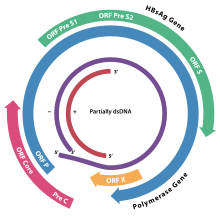Hepatitis B virus DNA polymerase is a hepatitis B viral protein.[1][2] It is a DNA polymerase that can use either DNA or RNA templates and a ribonuclease H that cuts RNA in the duplex. Both functions are supplied by the reverse transcriptase (RT) domain.
| Protein P (DNA polymerase / RNase H) | |||||||
|---|---|---|---|---|---|---|---|
 The genome organisation of HBV; the genes overlap. ORF P, in blue, encodes Hepatitis B virus DNA polymerase. | |||||||
| Identifiers | |||||||
| Organism | |||||||
| Symbol | P | ||||||
| UniProt | P03156 | ||||||
| |||||||
Structure
The hepadnaviral P protein is organized into three domains: an N-terminal domain (InterPro: IPR000201) covering the terminal and the spacer, an RT domain related to every other reverse transcriptase domain, and a C-terminal domain (InterPro: IPR001462) regulating the RNase H activity.
Furthermore, hepadnavirus polymerases contain a terminal protein (TP) domain that contains a tyrosine residue that serves as a primer for the synthesis of the (-) DNA strand.[3]
Function
The Hepatitis B virus (HBV) polymerase is a multifunctional enzyme, with both RNA-dependent and DNA-dependent polymerase functions, as well as an RNase H function. It acts on the HBV pre-genomic RNA (pgRNA) to reverse transcribe it to form a new rcDNA molecule within a new capsid. (The pgRNA has another function of being translated into the viral polymerase and core proteins).[3]
HBV core protein dimers are required for packaging of the pgRNA/polymerase complex. Then, after viral polymerase binds to the packaging signal (Hɛ) found at the 5′ end of the pgRNA, they are incorporated into the viral capsid.[3][4]
Inside the capsid, the pgRNA undergoes reverse transcription, which is initiated by protein priming at the tyrosine residue of the HBV polymerase. Thus, the (-) DNA strand is made.[4] At the same time, the RNA template is degraded by the RNase H activity of the polymerase. A short RNA of about 15–18 nucleotides at the 5′ end of the pgRNA (including the 5′ DR1 sequence) is not degraded and it is used as primer for (+) DNA strand synthesis.[3]
The resulting RC-DNA is partially double stranded. The (-) DNA strand is longer than a genome length, with a covalently bound polymerase and a redundant flap at the 5′ end. However, the (+) DNA strand synthesis is uncompleted by the polymerase, and there is a gap exists down to the 3′ end of the (+) DNA strand.[4]
References
Wikiwand in your browser!
Seamless Wikipedia browsing. On steroids.
Every time you click a link to Wikipedia, Wiktionary or Wikiquote in your browser's search results, it will show the modern Wikiwand interface.
Wikiwand extension is a five stars, simple, with minimum permission required to keep your browsing private, safe and transparent.
